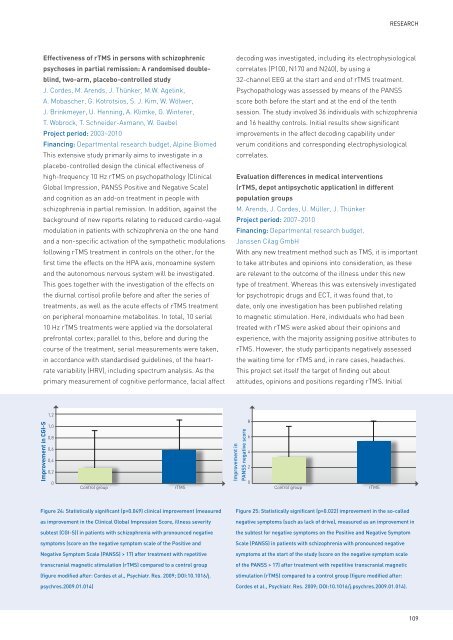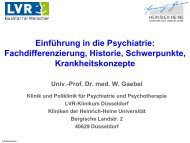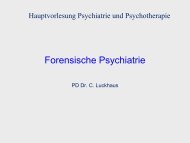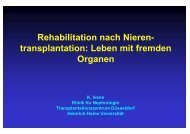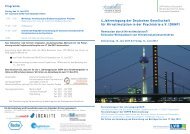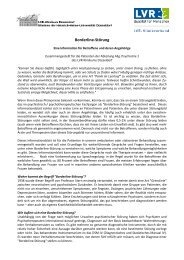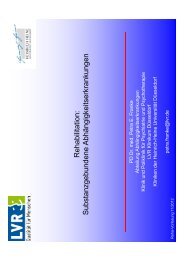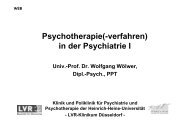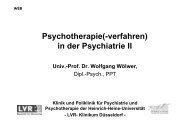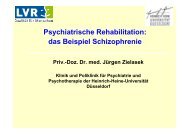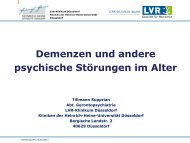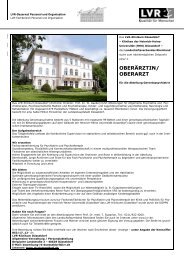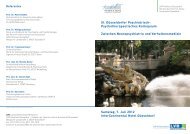LVR-Klinikum Düsseldorf Hospital of the Heinrich-Heine University ...
LVR-Klinikum Düsseldorf Hospital of the Heinrich-Heine University ...
LVR-Klinikum Düsseldorf Hospital of the Heinrich-Heine University ...
Create successful ePaper yourself
Turn your PDF publications into a flip-book with our unique Google optimized e-Paper software.
Effectiveness <strong>of</strong> rTMS in persons with schizophrenic<br />
psychoses in partial remission: A randomised doubleblind,<br />
two-arm, placebo-controlled study<br />
J. Cordes, M. Arends, J. Thünker, M.W. Agelink,<br />
A. Mobascher, G. Kotrotsios, S. J. Kim, W. Wölwer,<br />
J. Brinkmeyer, U. Henning, A. Klimke, G. Winterer,<br />
T. Wobrock, T. Schneider-Axmann, W. Gaebel<br />
Project period: 2003–2010<br />
Financing: Departmental research budget, Alpine Biomed<br />
This extensive study primarily aims to investigate in a<br />
placebo-controlled design <strong>the</strong> clinical effectiveness <strong>of</strong><br />
high-frequency 10 Hz rTMS on psychopathology (Clinical<br />
Global Impression, PANSS Positive and Negative Scale)<br />
and cognition as an add-on treatment in people with<br />
schizophrenia in partial remission. In addition, against <strong>the</strong><br />
background <strong>of</strong> new reports relating to reduced cardio-vagal<br />
modulation in patients with schizophrenia on <strong>the</strong> one hand<br />
and a non-specific activation <strong>of</strong> <strong>the</strong> sympa<strong>the</strong>tic modulations<br />
following rTMS treatment in controls on <strong>the</strong> o<strong>the</strong>r, for <strong>the</strong><br />
first time <strong>the</strong> effects on <strong>the</strong> HPA axis, monoamine system<br />
and <strong>the</strong> autonomous nervous system will be investigated.<br />
This goes toge<strong>the</strong>r with <strong>the</strong> investigation <strong>of</strong> <strong>the</strong> effects on<br />
<strong>the</strong> diurnal cortisol pr<strong>of</strong>ile before and after <strong>the</strong> series <strong>of</strong><br />
treatments, as well as <strong>the</strong> acute effects <strong>of</strong> rTMS treatment<br />
on peripheral monoamine metabolites. In total, 10 serial<br />
10 Hz rTMS treatments were applied via <strong>the</strong> dorsolateral<br />
prefrontal cortex; parallel to this, before and during <strong>the</strong><br />
course <strong>of</strong> <strong>the</strong> treatment, serial measurements were taken,<br />
in accordance with standardised guidelines, <strong>of</strong> <strong>the</strong> heartrate<br />
variability (HRV), including spectrum analysis. As <strong>the</strong><br />
primary measurement <strong>of</strong> cognitive performance, facial affect<br />
Improvement in CGI-S<br />
1,2<br />
1,0<br />
0,8<br />
0,6<br />
0,4<br />
0,2<br />
0<br />
Control group rTMS<br />
Figure 24: Statistically significant (p=0.049) clinical improvement (measured<br />
as improvement in <strong>the</strong> Clinical Global Impression Score, illness severity<br />
subtest (CGI-S)) in patients with schizophrenia with pronounced negative<br />
symptoms (score on <strong>the</strong> negative symptom scale <strong>of</strong> <strong>the</strong> Positive and<br />
Negative Symptom Scale (PANSS) > 17) after treatment with repetitive<br />
transcranial magnetic stimulation (rTMS) compared to a control group<br />
(figure modified after: Cordes et al., Psychiatr. Res. 2009; DOI:10.1016/j.<br />
psychres.2009.01.014)<br />
ReseaRch<br />
decoding was investigated, including its electrophysiological<br />
correlates (P100, N170 and N240), by using a<br />
32-channel EEG at <strong>the</strong> start and end <strong>of</strong> rTMS treatment.<br />
Psychopathology was assessed by means <strong>of</strong> <strong>the</strong> PANSS<br />
score both before <strong>the</strong> start and at <strong>the</strong> end <strong>of</strong> <strong>the</strong> tenth<br />
session. The study involved 36 individuals with schizophrenia<br />
and 16 healthy controls. Initial results show significant<br />
improvements in <strong>the</strong> affect decoding capability under<br />
verum conditions and corresponding electrophysiological<br />
correlates.<br />
Evaluation differences in medical interventions<br />
(rTMS, depot antipsychotic application) in different<br />
population groups<br />
M. Arends, J. Cordes, U. Müller, J. Thünker<br />
Project period: 2007–2010<br />
Financing: Departmental research budget,<br />
Janssen Cilag GmbH<br />
With any new treatment method such as TMS, it is important<br />
to take attributes and opinions into consideration, as <strong>the</strong>se<br />
are relevant to <strong>the</strong> outcome <strong>of</strong> <strong>the</strong> illness under this new<br />
type <strong>of</strong> treatment. Whereas this was extensively investigated<br />
for psychotropic drugs and ECT, it was found that, to<br />
date, only one investigation has been published relating<br />
to magnetic stimulation. Here, individuals who had been<br />
treated with rTMS were asked about <strong>the</strong>ir opinions and<br />
experience, with <strong>the</strong> majority assigning positive attributes to<br />
rTMS. However, <strong>the</strong> study participants negatively assessed<br />
<strong>the</strong> waiting time for rTMS and, in rare cases, headaches.<br />
This project set itself <strong>the</strong> target <strong>of</strong> finding out about<br />
attitudes, opinions and positions regarding rTMS. Initial<br />
Improvement in<br />
PANSS negative score<br />
8<br />
6<br />
4<br />
2<br />
0<br />
Control group rTMS<br />
Figure 25: Statistically significant (p=0.022) improvement in <strong>the</strong> so-called<br />
negative symptoms (such as lack <strong>of</strong> drive), measured as an improvement in<br />
<strong>the</strong> subtest for negative symptoms on <strong>the</strong> Positive and Negative Symptom<br />
Scale (PANSS) in patients with schizophrenia with pronounced negative<br />
symptoms at <strong>the</strong> start <strong>of</strong> <strong>the</strong> study (score on <strong>the</strong> negative symptom scale<br />
<strong>of</strong> <strong>the</strong> PANSS > 17) after treatment with repetitive transcranial magnetic<br />
stimulation (rTMS) compared to a control group (figure modified after:<br />
Cordes et al., Psychiatr. Res. 2009; DOI:10.1016/j.psychres.2009.01.014).<br />
109


